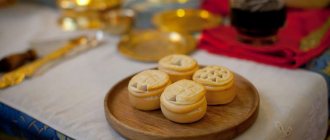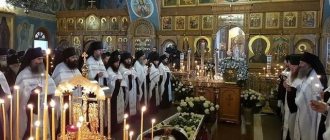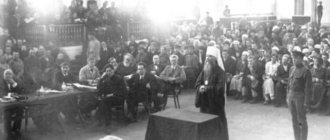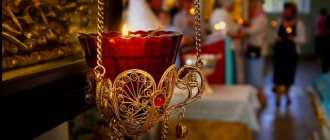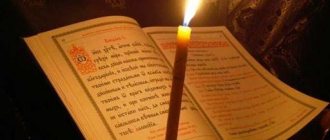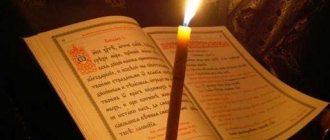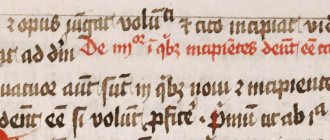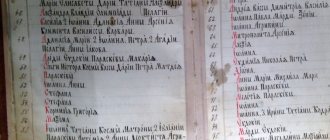Proskomedia
Sometimes you can hear the opinion of experienced confessors that whoever comes to church before the start of the designated time of the liturgy receives special God's grace . The point is not only that in the midst of a quiet, almost empty temple one easily thinks about Eternity and prays. At this time, the liturgy actually begins - its first part, visible to few people.
Definition: what is prosocomydia
Now this is the preparation of the “substance of the Sacrament” of the Eucharist , that is, bread, wine, for the celebration of the liturgy. It is performed by the priest on the altar, which is located in the southern part of the altar.
The Greek name, meaning “offering,” testifies to the ancient custom of believers to donate bread, as well as wine, for worship.
Is mass a church service or a type of prayer?
Every Orthodox Christian knows that the main central service of worship is the Liturgy. However, when submitting a note about health or repose in church, you can hear questions: “Are you submitting for Proskomedia? Maybe order Mass? No, it’s better for you to pray,” etc. Even a churchgoer can easily become confused. Mass - what is it? Is this a prayer or part of a worship service? Is it different from the Liturgy? We will answer these questions in this article.
Orthodox Liturgy
Liturgical prosphora at the proskomedia
the Eastern Christian that has developed since the first centuries , the liturgy is celebrated on leavened (that is, prepared using leaven) bread. Round in shape (this is a universal symbol of Eternity), it seems to be composed of two parts. This symbolizes the union of the Divine and Human in the Lord
At the top of the sacrificial bread you can see the image of the Cross, as well as two inscriptions:
- in Slavic: “IС ХС” (this is the name “ Jesus Christ ”);
- below is the Greek word “NI-KA” meaning victory.
The current image of liturgical bread was introduced after the liturgical reform of Patriarch Nikon (1653-1666), until the middle of the 17th century. The “seal,” as the image is called, looked a little different, representing the Cross with the instruments of the Crucifixion—a spear, a cane.
At the liturgy (respectively, also at the proskomedia) over the centuries-old history of the Church, a different number of prosphoras was accepted: from 1 or 3 (which is evidenced, for example, by liturgical books of the 12th-13th centuries adopted in Rus') to 5 or 7. From the middle In the 17th century, after the reform of Patriarch Nikon, 5 were established, symbolizing the saturation of 5,000 believers by Christ with 5 loaves of bread in the desert. However, for the communion of believers, only one of them is used, called the Lamb .
What kind of bread and wine are used when performing proskomedia?
Not all bread and wine are suitable for proskomedia. Bread, also called prosphora, must be leavened, wheat, round, clean, fresh, two-part (that is, consisting of two parts: upper and lower); The wine for proskomedia requires red grape wine, since the red color resembles the color of blood (although white wine is also allowed in the Romanian Orthodox Church). In practice, Cahors is used for proskomedia, which, however, is not a statutory requirement.
Essence and symbolism
During the rite, liturgical bread is prepared, as well as wine and water for the celebration of the Eucharist. All objects standing on the altar on which this part of the service takes place have a deep symbolic meaning, recalling:
- At the Birth of Christ, the manger where the Baby was laid symbolizes the dish on which the particles, the paten, are placed; the same event is symbolized by an asterisk - the symbol of the star of Bethlehem, which helped the “magi from the East” find the Divine Child;
- The Last Supper, when the Lord gave the disciples a cup of wine with the words: “Drink from it, all of you, for this is My Blood of the New Testament, which is shed for many for the remission of sins” (Matthew 26:27-28).
- Crucifixion; the “spear” with which the priest divides the prosphora into parts, as well as the cruciform shape of the star, reminds of him;
- Resurrection - the inscription “NI-KA” means victory over death.
The procedure for performing proskomedia
Its beginning can be seen if you come to the temple about half an hour before the start of the service. The royal doors are closed, the curtain is drawn. Standing on the ambo facing the throne, the priest (sometimes several priests), as well as the deacons, pray in low voices. Regularly praying parishioners easily recognize “Our Father” and “Trisagion”. Having bowed to the people, the ministers enter the altar. The serving priest puts on full vestments, after which the rite itself begins:
- The priest pronounces his first words, “Blessed be our God,” loudly, because they also begin the reading of the service of the Third Hour; it is followed by the rite of the Sixth Hour, and all hours end by the time of the completion of Proskomedia;
- then the priest takes the Lamb prosphora, baptizes it three times with a copy with quietly pronounced words: “In remembrance of the Lord and God and our Savior Jesus Christ”; after that he cuts out the middle part so that it looks like a cube; at the same time he pronounces the words of the prophet. Isaiah : “Like a sheep being led to the slaughter, and like a Lamb without blemish, even the one who shears it is silent, so He opens not His mouth; in His humility His judgment will be taken; Who will confess His generation? as if His belly were lifted up from the earth” (Is. 53:7-8); this is the Lamb with whom Christians will partake; the priest places this part on the paten, after which, turning it over, he makes a cross-shaped cut from below; the right side of the Lamb is pierced by a spear, just as a warrior once struck the already dead Savior in the ribs;
The remaining parts of the Lamb are called “antidor,” which literally means “instead of the Gifts,” because only the Lamb is transposed into the body of Christ. Other parts of the prosphora are broken up and distributed to the believers at the end of the service.
- after this, the priest blesses the vessel with wine, which is already on the altar; the wine is poured into the Chalice, where a little water is also added at the same time; this is also a memory of the Crucifixion, when “from the ribs” of the deceased Christ “blood and water came forth”;
- from the second prosphora, which is called the Mother of God, a triangular particle is extracted; it is placed on a dish to the right of Angz;
- then the priest takes the so-called “nine-time” prosphora to remove particles of saints from it: these are St. John the Baptist, Christ's Apostles , prophets, bishops, as well as martyrs, unmercenaries, and finally, the right. Joachim and Anna, father and mother of the Virgin Mary; the particle about the creator of the rite of the liturgy is necessarily taken out;
- particles from the fourth prosphora are prayerfully offered for the health of living Orthodox Christians, including the priest himself performing the service;
- and the fifth is considered funeral;
- finally, the turn of the liturgical bread comes - the donations of the faithful; from them the priest takes out particles about health, repose, while pronouncing the names from the submitted notes; most often there are a lot of them, so the deacon reads them; a separate particle is taken out about each person; taken out for health and repose, they are placed on the paten below the Lamb.
Scheme. Procomidia. Prosphora: 1. Lamb 2. Mother of God 3. Nine-time 4. Congratulations 5. Funeral prosphora
At the end of the Eucharist, particles of prosphora will be immersed in the chalice with the Blood of Christ with a special short prayer, which sounds like this:
“Wash away, O Lord, the sins of those who were remembered here by Thy honest Blood, by the prayers of Thy saints.”.
The rite ends with the blessing of the censer, which is offered by the deacon. Having covered the covers with fragrant smoke, the priest covers the chalice and paten with them.
Preparation for the ceremony
In the process of preparing for proskomedia, certain actions are performed, prescribed by the rules of the Orthodox Church.
Entrance prayers
A good Christian precedes any task with prayer. When entering the temple and preparing for the liturgy, the priests say entrance prayers. The Church has prescribed the necessary ritual and sequence of reading prayers for the priest and deacon:
- At the entrance to the altar there are three bows, reading prayers, troparions for repentance.
- Kissing the icons of the Lord and the Virgin Mary.
- Reading troparions of repentance, bowing to each other and the flock, asking for forgiveness.
- They read “I will enter your house,” enter the altar, venerate the icons, kiss the altar, the cross, and the Gospel.
Next, in the sacristy, both participants in the proskomedia dress up for the service.
vestment
The priest's vestments are kept in the sacristy or in the corner of the altar. The Holy Father gives a blessing to the deacon and begins to dress himself. The following rules are followed when dressing:
- kissing the cross on every type of vestment;
- When putting on each part, the prayer prescribed by the charter is performed.
The priest and deacon vest themselves side by side, in close quarters, taking turns.
Washing your hands
The tradition of washing hands before starting proskomedia dates back to Old Testament times. In ancient times, priests washed their hands and feet before performing the sacraments; special bowls stood at the entrance to the temple for parishioners. Washing your hands is a symbolic cleansing of not only the body from dirt, but also the soul from sins. During ablution, verses of Psalm 25 are read.
Preparing the Altar and Vessels
Having completed the ablution, the priest proceeds to prepare the Eucharistic utensils for the proskomedia. He goes to the altar, removes the covers and protective vessels, lights a lamp - a lamp or a candle. The vessels are arranged in a certain way, turning the side with the image of Christ towards you:
- on the left is a paten;
- on the right is a chalice.
Wine, water, prosphora are prepared and placed on the altar.
Note: the Church Service Book does not specify at what time the utensils for the proskomedia should be prepared. Preparation is often carried out before vesting.
What does “Proskomedia on peace and health” mean?
This means that for this or that person, living or deceased, a particle will be taken out with a short prayer; “Remember, Lord (name).”
Then she will be laid on the paten, and at the end of the liturgy, she will be prayerfully immersed in the Blood of Christ.
Who can be remembered at the proskomedia
Notes are submitted only about those who have been baptized. You also cannot write the names of people of other faiths.
There is plenty of evidence of how beneficial such commemoration is for our dead. It brings no less benefit to the living, but one can also come across a warning urging one to approach the notes with reasoning: such commemorations are best given for those who are churchgoers (leading church life, regularly taking the Sacraments) or at least sometimes attending services.
If a person, for example, is a stubborn atheist, but was baptized (for example, in childhood), many confessors advise it is better to read the Psalter about him. After all, commemoration at Proskomedia essentially ends with communion with the Sacrament of the Eucharist, for which such a soul may not be ready. This is especially true for long-term commemorations at Proskomedia - Sorokoustov.
Who can be remembered at the proskomedia?
The notes contain the names of only those baptized in the Orthodox Church. In many churches, especially monasteries, notes for proskomedia may not be accepted if those for whom they are asked to pray are not faithful: they do not participate in church Sacraments, they are not churchgoers. The Venerable Leo of Optina said: “A spiritual person rightly told you about the commemoration at Proskomedia that sinners who are in error and schism should not be clearly remembered: according to the interpretation of church teachers, through the combination of particles taken out for their names with the Divine Blood, not cleansing, but the highest condemnation occurs for them. For a sinner who has repented and begun to reform, you can pray and submit to Proskomedia.”
Registered note and Proskomedia: what is the difference
Different churches have different traditions of remembering Christians and submitting notes, so the answers of pastors to such questions are often quite contradictory:
- you can find notes divided into “simple” (only prayer at the altar, as well as at the litany, for the health or repose of a Christian), as well as “custom” (with the removal of a particle from the prosphora);
- sometimes you can also see the concepts of “note with prosphora” or “for proskomedia”, but at the same time you can also come across “custom mass”; then it is necessary to clarify what exactly is meant; for example, it could be a proskomedia, as well as a commemoration at a litany;
- finally, there is an opinion according to which all names given in notes should be commemorated at the proskomedia; then there is no longer any difference between a “simple” note and a proskomedia.
This is how, for example, Archpriest speaks about it. Alexy Uminsky:
“Both simple and custom notes are a sacrifice made by the parishioner. The word proskomedia means offering, and in the ancient church it was carried out in the temple through the bringing of bread and wine for the sacred rite... All names that are brought to the temple are read before the Eucharistic cup, and at proskomedia for each name a particle is taken out, which is immersed in the cup with the Blood of the Lord with a prayer that the Lord would wash those remembered here with His honest Blood and the prayers of His saints.”
Thus, the practice of modern church life is such that questions about the meaning of notes “with prosphora”, “simple”, “custom” are best asked in a specific church.
What is a litany
The Greek word is translated as “long prayer.” These are special short prayers performed by believers collectively. Therefore, the deacon proclaims the petitions, and the people continue them with the words “Lord, have mercy!” Nowadays they are usually sung by a church choir.
Church choir
Petitions are raised for the Church, its Primate, the “authorities and army” of the state, for the prosperity of the country, as well as special petitions for believers when the deacon reads the submitted notes. As a rule, according to the multitude of them, the names of those commemorated at the altar are read simultaneously - by the priest (sometimes more than one), by the altar servers. Therefore, it is unreasonable to wait for the names of loved ones to be heard “loudly”; it is better to join the common congregational prayer.
Why are other prosphora needed (besides the Lamb)?
From the second prosphora, called the Mother of God, a particle is taken out in memory of the Mother of God, it is placed on the paten on the right side of the Lamb. From the third prosphora - the nine-rank one - nine particles are taken out in honor of the nine angelic orders, as well as in memory of John the Baptist, the prophets, apostles, saints, martyrs, saints, unmercenaries, Godfather Joachim and Anna (parents of the Most Holy Theotokos) and that saint whose Liturgy is being celebrated on this day (John Chrysostom or Basil the Great). These particles are placed in three columns, to the left of the Lamb. From the fourth prosphora, particles for the living are taken out and placed on the paten below the Lamb; from the fifth - for the dead (deceased), these particles are placed below the particles taken out for the living. In ancient times, Christians baked prosphora themselves (and in Greece this practice still occurs today), brought it to the proskomedia, and the priest took out particles from them and returned the bread to the owner.
When to submit notes to the proskomedia about health and repose
When it is customary to take out particles of prosphoras for everyone whose names are in all notes, the prosphoras, which are sometimes also called “private”, can even be several hundred, and several priests can perform proskomedia at once. Often the particles are then removed:
- already the day before, during the evening service;
- in the morning, not only before the liturgy, but even directly during it - before the Great Entrance, when the Gifts are transferred from the altar to the throne; only from this moment on, commemoration of this kind is no longer possible.
It is in view of this circumstance that in many churches the sextons, the readers, go several times during the liturgy and go out into the narthex, where notes are received in order to take to the altar those that the believers submit in the morning. But after the Great Entrance, commemoration is accepted only at the next Proskomedia.
In any case, piety requires submitting notes the night before, or in the morning before the service, so as not to take away your time by standing at the candle box during the service itself.
The meaning of proskomedia
In Pskov there is an ancient Spaso-Mirozhsky monastery, preserved from the first centuries after the Baptism of Rus', with the cathedral church of the Transfiguration of the Lord - one of the few that have come down to us from the time before the Mongol invasion. Here, as modern historians have established, there is a deaconnik, unique from the point of view of modern practice (this is the name given to the place where liturgical vessels, utensils, and vestments were kept, which were in charge of the deacons).
The deacon was completely open to parishioners, as, indeed, it was then in many churches in Rus'. People brought candles here, kutya, which they donated as alms for the repose of the dead, and, of course, bread for the liturgy, which they often baked themselves at home, and wine. For them, the meaning of Proskomedia was, of course, clear: it is, as far as is possible for our weakness, human participation in the performance of the Sacrament, preceding that “great and unexplored, glorious and terrible” that will no longer be accomplished by man, but through a man, a priest of God.
Natalia Sazonova
Prayer
God, our God, Heavenly Bread, food for the whole world, sending our Lord and God Jesus Christ, Savior and Deliverer and Benefactor, blessing and sanctifying us, Himself bless this offer, and accept it freely Your heavenly altar.
Remember that you are good and a lover of mankind, who brought and for the sake of whom they brought, and preserve us uncondemned in the priesthood of Your Divine Mysteries. For hallowed and glorified be Thy most honorable and magnificent name, the Father, and the Son, and the Holy Spirit, now and ever, and unto the ages of ages. Amen.
